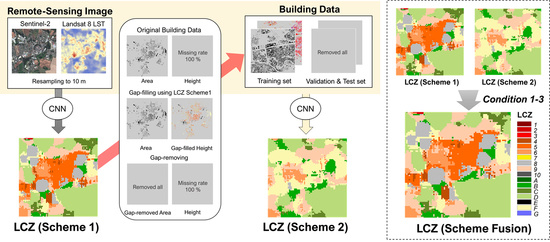Improving Local Climate Zone Classification Using Incomplete Building Data and Sentinel 2 Images Based on Convolutional Neural Networks
Abstract
1. Introduction
2. Study Area and Data Processing
2.1. Study Area
2.2. LCZ Reference Data
2.3. Satellite Input Data
2.4. Building Data
3. Methodology
3.1. Convolutional Neural Networks (CNN) Classifier
3.2. LCZ Mapping Strategies
- Condition 1: PS1 > PS2.
- Condition 2: If S1 is classified as urban-type LCZ (LCZ1-10), but S2 is classified as natural-type (LCZA-G).
- Condition 3: If S1 is classified as compact urban-type LCZ (LCZ1-3) and PS1 is 1 (100% confident), but S2 is not (LCZ4-G).
3.3. Modeling and Accuracy Assessment
3.4. Evaluation for the Regions of Missing Building Information
4. Results and Discussion
4.1. Overall Accuracy Assessment
4.2. Mapping LCZ for Three Schemes
4.3. Impact of Missing Building Information
4.4. Novelty, Limitations, and Future Directions
5. Conclusions
Supplementary Materials
Author Contributions
Funding
Acknowledgments
Conflicts of Interest
References
- DESA, U. World Urbanization Prospects 2018: Highlights; ST/ESA/SER. A/421; Department of Economic and Social Affairs Population Division: New York, NY, USA, 2019. [Google Scholar]
- Mohan, M.; Sati, A.P.; Bhati, S. Urban sprawl during five decadal period over National Capital Region of India: Impact on urban heat island and thermal comfort. Urban Clim. 2020, 33, 100647. [Google Scholar] [CrossRef]
- Weng, Q.; Lu, D.; Schubring, J. Estimation of land surface temperature–vegetation abundance relationship for urban heat island studies. Remote Sens. Environ. 2004, 89, 467–483. [Google Scholar] [CrossRef]
- Argüeso, D.; Evans, J.P.; Fita, L.; Bormann, K.J. Temperature response to future urbanization and climate change. Clim. Dyn. 2014, 42, 2183–2199. [Google Scholar] [CrossRef]
- Oleson, K.; Monaghan, A.; Wilhelmi, O.; Barlage, M.; Brunsell, N.; Feddema, J.; Hu, L.; Steinhoff, D. Interactions between urbanization, heat stress, and climate change. Clim. Chang. 2015, 129, 525–541. [Google Scholar] [CrossRef]
- Shahmohamadi, P.; Che-Ani, A.; Maulud, K.; Tawil, N.; Abdullah, N. The impact of anthropogenic heat on formation of urban heat island and energy consumption balance. Urban Stud. Res. 2011. [Google Scholar] [CrossRef]
- Yoo, C.; Im, J.; Park, S.; Quackenbush, L.J. Estimation of daily maximum and minimum air temperatures in urban landscapes using MODIS time series satellite data. ISPRS J. Photogramm. Remote Sens. 2018, 137, 149–162. [Google Scholar] [CrossRef]
- Chapman, S.; Watson, J.E.; Salazar, A.; Thatcher, M.; McAlpine, C.A. The impact of urbanization and climate change on urban temperatures: A systematic review. Landsc. Ecol. 2017, 32, 1921–1935. [Google Scholar] [CrossRef]
- Bechtel, B.; Demuzere, M.; Mills, G.; Zhan, W.; Sismanidis, P.; Small, C.; Voogt, J. SUHI analysis using Local Climate Zones—A comparison of 50 cities. Urban Clim. 2019, 28, 100451. [Google Scholar] [CrossRef]
- Umezaki, A.S.; Ribeiro, F.N.D.; de Oliveira, A.P.; Soares, J.; de Miranda, R.M. Numerical characterization of spatial and temporal evolution of summer urban heat island intensity in São Paulo, Brazil. Urban Clim. 2020, 32, 100615. [Google Scholar] [CrossRef]
- Friedl, M.A.; Sulla-Menashe, D.; Tan, B.; Schneider, A.; Ramankutty, N.; Sibley, A.; Huang, X. MODIS Collection 5 global land cover: Algorithm refinements and characterization of new datasets. Remote. Sens. Environ. 2010, 114, 168–182. [Google Scholar] [CrossRef]
- Bontemps, S.; Defourny, P.; Van Bogaert, E.; Arino, O.; Kalogirou, V.; Perez, J.R. GLOBCOVER 2009 Products Description and Validation Report. 2011. Available online: http://ionia1.esrin.esa.int/docs/GLOBCOVER2009_Validation_Report_2 (accessed on 1 August 2020).
- Stewart, I.D.; Oke, T.R. Local climate zones for urban temperature studies. Bull. Am. Meteorol. Soc. 2012, 93, 1879–1900. [Google Scholar] [CrossRef]
- Unger, J.; Lelovics, E.; Gál, T. Local Climate Zone mapping using GIS methods in Szeged. Hung. Geogr. Bull. 2014, 63, 29–41. [Google Scholar] [CrossRef]
- Wang, R.; Ren, C.; Xu, Y.; Lau, K.K.-L.; Shi, Y. Mapping the local climate zones of urban areas by GIS-based and WUDAPT methods: A case study of Hong Kong. Urban Clim. 2018, 24, 567–576. [Google Scholar] [CrossRef]
- Zheng, Y.; Ren, C.; Xu, Y.; Wang, R.; Ho, J.; Lau, K.; Ng, E. GIS-based mapping of Local Climate Zone in the high-density city of Hong Kong. Urban Clim. 2018, 24, 419–448. [Google Scholar] [CrossRef]
- Qiu, C.; Schmitt, M.; Mou, L.; Ghamisi, P.; Zhu, X.X. Feature importance analysis for local climate zone classification using a residual convolutional neural network with multi-source datasets. Remote Sens. 2018, 10, 1572. [Google Scholar] [CrossRef]
- Yoo, C.; Han, D.; Im, J.; Bechtel, B. Comparison between convolutional neural networks and random forest for local climate zone classification in mega urban areas using Landsat images. ISPRS J. Photogramm. Remote Sens. 2019, 157, 155–170. [Google Scholar] [CrossRef]
- Fan, H.; Zipf, A.; Fu, Q.; Neis, P. Quality assessment for building footprints data on OpenStreetMap. Int. J. Geogr. Inf. Sci. 2014, 28, 700–719. [Google Scholar] [CrossRef]
- Geletič, J.; Lehnert, M.; Dobrovolný, P. Land surface temperature differences within local climate zones, based on two central European cities. Remote Sens. 2016, 8, 788. [Google Scholar] [CrossRef]
- Demuzere, M.; Bechtel, B.; Middel, A.; Mills, G. Mapping Europe into local climate zones. PLoS ONE 2019, 14, e0214474. [Google Scholar] [CrossRef]
- Bechtel, B.; Alexander, P.J.; Böhner, J.; Ching, J.; Conrad, O.; Feddema, J.; Mills, G.; See, L.; Stewart, I. Mapping local climate zones for a worldwide database of the form and function of cities. ISPRS Int. J. Geo-Inf. 2015, 4, 199–219. [Google Scholar] [CrossRef]
- Beck, C.; Straub, A.; Breitner, S.; Cyrys, J.; Philipp, A.; Rathmann, J.; Schneider, A.; Wolf, K.; Jacobeit, J. Air temperature characteristics of local climate zones in the Augsburg urban area (Bavaria, southern Germany) under varying synoptic conditions. Urban Clim. 2018, 25, 152–166. [Google Scholar] [CrossRef]
- Cai, M.; Ren, C.; Xu, Y.; Lau, K.K.-L.; Wang, R. Investigating the relationship between local climate zone and land surface temperature using an improved WUDAPT methodology–A case study of Yangtze River Delta, China. Urban Clim. 2018, 24, 485–502. [Google Scholar] [CrossRef]
- Giridharan, R.; Emmanuel, R. The impact of urban compactness, comfort strategies and energy consumption on tropical urban heat island intensity: A review. Sustain. Cities Soc. 2018, 40, 677–687. [Google Scholar] [CrossRef]
- Kaloustian, N.; Bechtel, B. Local climatic zoning and urban heat island in Beirut. Procedia Eng. 2016, 169, 216–223. [Google Scholar] [CrossRef]
- Rosentreter, J.; Hagensieker, R.; Waske, B. Towards large-scale mapping of local climate zones using multitemporal Sentinel 2 data and convolutional neural networks. Remote Sens. Environ. 2020, 237, 111472. [Google Scholar] [CrossRef]
- Verdonck, M.-L.; Okujeni, A.; van der Linden, S.; Demuzere, M.; De Wulf, R.; Van Coillie, F. Influence of neighbourhood information on ‘Local Climate Zone’mapping in heterogeneous cities. Int. J. Appl. Earth Obs. Geoinf. 2017, 62, 102–113. [Google Scholar] [CrossRef]
- Geletič, J.; Lehnert, M.; Savić, S.; Milošević, D. Inter-/intra-zonal seasonal variability of the surface urban heat island based on local climate zones in three central European cities. Build. Environ. 2019, 156, 21–32. [Google Scholar] [CrossRef]
- Essa, W.; van der Kwast, J.; Verbeiren, B.; Batelaan, O. Downscaling of thermal images over urban areas using the land surface temperature–impervious percentage relationship. Int. J. Appl. Earth Obs. Geoinf. 2013, 23, 95–108. [Google Scholar] [CrossRef]
- Kim, M.; Lee, J.; Im, J. Deep learning-based monitoring of overshooting cloud tops from geostationary satellite data. GIScience Remote Sens. 2018, 55, 763–792. [Google Scholar] [CrossRef]
- Liu, T.; Abd-Elrahman, A.; Morton, J.; Wilhelm, V.L. Comparing fully convolutional networks, random forest, support vector machine, and patch-based deep convolutional neural networks for object-based wetland mapping using images from small unmanned aircraft system. GIScience Remote Sens. 2018, 55, 243–264. [Google Scholar] [CrossRef]
- Sothe, C.; De Almeida, C.; Schimalski, M.; La Rosa, L.; Castro, J.; Feitosa, R.; Dalponte, M.; Lima, C.; Liesenberg, V.; Miyoshi, G. Comparative performance of convolutional neural network, weighted and conventional support vector machine and random forest for classifying tree species using hyperspectral and photogrammetric data. GIScience Remote Sens. 2020, 57, 369–394. [Google Scholar] [CrossRef]
- Zhang, C.; Pan, X.; Li, H.; Gardiner, A.; Sargent, I.; Hare, J.; Atkinson, P.M. A hybrid MLP-CNN classifier for very fine resolution remotely sensed image classification. ISPRS J. Photogramm. Remote Sens. 2018, 140, 133–144. [Google Scholar] [CrossRef]
- Zhao, S.; Liu, X.; Ding, C.; Liu, S.; Wu, C.; Wu, L. Mapping rice paddies in complex landscapes with convolutional neural networks and phenological metrics. GIScience Remote Sens. 2020, 57, 37–48. [Google Scholar] [CrossRef]
- Yu, X.; Wu, X.; Luo, C.; Ren, P. Deep learning in remote sensing scene classification: A data augmentation enhanced convolutional neural network framework. GIScience Remote Sens. 2017, 54, 741–758. [Google Scholar] [CrossRef]
- Al-Najjar, H.A.; Kalantar, B.; Pradhan, B.; Saeidi, V.; Halin, A.A.; Ueda, N.; Mansor, S. Land cover classification from fused DSM and UAV images using convolutional neural networks. Remote Sens. 2019, 11, 1461. [Google Scholar] [CrossRef]
- Fu, G.; Liu, C.; Zhou, R.; Sun, T.; Zhang, Q. Classification for high resolution remote sensing imagery using a fully convolutional network. Remote Sens. 2017, 9, 498. [Google Scholar] [CrossRef]
- Lee, J.; Han, D.; Shin, M.; Im, J.; Lee, J.; Quackenbush, L.J. Different Spectral Domain Transformation for Land Cover Classification Using Convolutional Neural Networks with Multi-Temporal Satellite Imagery. Remote Sens. 2020, 12, 1097. [Google Scholar] [CrossRef]
- Marcos, D.; Volpi, M.; Kellenberger, B.; Tuia, D. Land cover mapping at very high resolution with rotation equivariant CNNs: Towards small yet accurate models. ISPRS J. Photogramm. Remote Sens. 2018, 145, 96–107. [Google Scholar] [CrossRef]
- Boureau, Y.-L.; Ponce, J.; LeCun, Y. A theoretical analysis of feature pooling in visual recognition. In Proceedings of the 27th international conference on machine learning (ICML-10), Haifa, Israel, 21–24 June 2010; pp. 111–118. [Google Scholar]
- Kingma, D.P.; Ba, J. Adam: A method for stochastic optimization. In Proceedings of the International Conference on Learning Representations, San Diego, CA, USA, 7–9 May 2015. [Google Scholar]
- Krizhevsky, A.; Sutskever, I.; Hinton, G.E. Imagenet classification with deep convolutional neural networks. In Proceedings of the Advances in Neural Information Processing Systems, Lake Tahoe, NV, USA, 3–6 December 2012; pp. 1097–1105. [Google Scholar]
- Fonte, C.C.; Lopes, P.; See, L.; Bechtel, B. Using OpenStreetMap (OSM) to enhance the classification of local climate zones in the framework of WUDAPT. Urban Clim. 2019, 28, 100456. [Google Scholar] [CrossRef]
- Zhang, G.; Ghamisi, P.; Zhu, X.X. Fusion of heterogeneous earth observation data for the classification of local climate zones. IEEE Trans. Geosci. Remote Sens. 2019, 57, 7623–7642. [Google Scholar] [CrossRef]
- Brousse, O.; Wouters, H.; Demuzere, M.; Thiery, W.; Van de Walle, J.; Van Lipzig, N.P. The local climate impact of an African city during clear-sky conditions—Implications of the recent urbanization in Kampala (Uganda). Int. J. Climatol. 2020. [Google Scholar] [CrossRef]
- Mu, Q.; Miao, S.; Wang, Y.; Li, Y.; He, X.; Yan, C. Evaluation of employing local climate zone classification for mesoscale modelling over Beijing metropolitan area. Meteorol. Atmos. Phys. 2020, 132, 315–326. [Google Scholar] [CrossRef]
- Ochola, E.M.; Fakharizadehshirazi, E.; Adimo, A.O.; Mukundi, J.B.; Wesonga, J.M.; Sodoudi, S. Inter-local climate zone differentiation of land surface temperatures for Management of Urban Heat in Nairobi City, Kenya. Urban Clim. 2020, 31, 100540. [Google Scholar] [CrossRef]
- Aung, H.T.; Pha, S.H.; Takeuchi, W. Building footprint extraction in Yangon city from monocular optical satellite image using deep learning. Geocarto Int. 2020, 1–21. [Google Scholar] [CrossRef]
- Milosavljević, A. Automated Processing of Remote Sensing Imagery Using Deep Semantic Segmentation: A Building Footprint Extraction Case. ISPRS Int. J. Geo-Inf. 2020, 9, 486. [Google Scholar] [CrossRef]
- Li, M.; Koks, E.; Taubenböck, H.; van Vliet, J. Continental-scale mapping and analysis of 3D building structure. Remote Sens. Environ. 2020, 245, 111859. [Google Scholar] [CrossRef]
- Li, X.; Zhou, Y.; Gong, P.; Seto, K.C.; Clinton, N. Developing a method to estimate building height from Sentinel-1 data. Remote Sens. Environ. 2020, 240, 111705. [Google Scholar] [CrossRef]
- Soergel, U.; Michaelsen, E.; Thiele, A.; Cadario, E.; Thoennessen, U. Stereo analysis of high-resolution SAR images for building height estimation in cases of orthogonal aspect directions. ISPRS J. Photogramm. Remote Sens. 2009, 64, 490–500. [Google Scholar] [CrossRef]
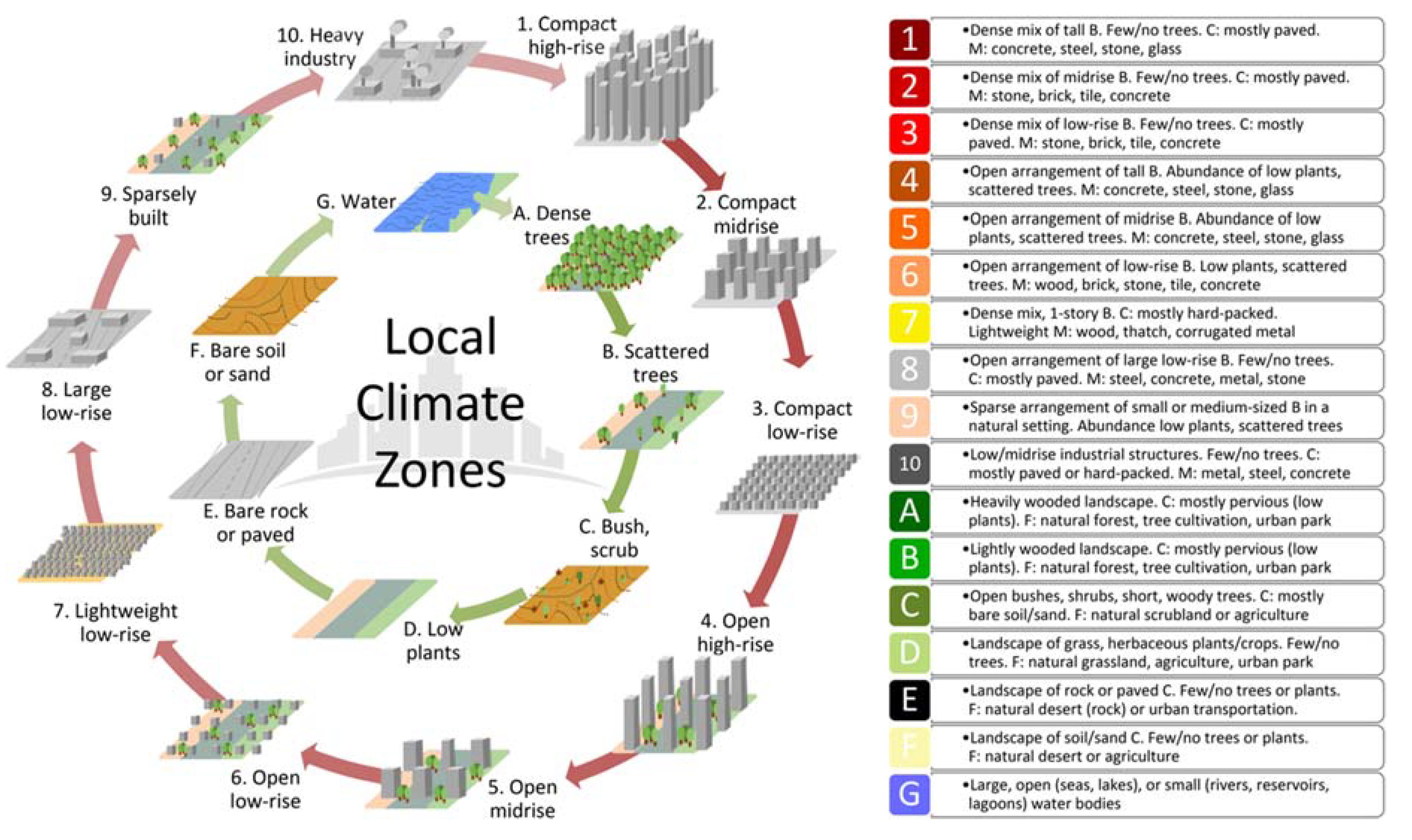
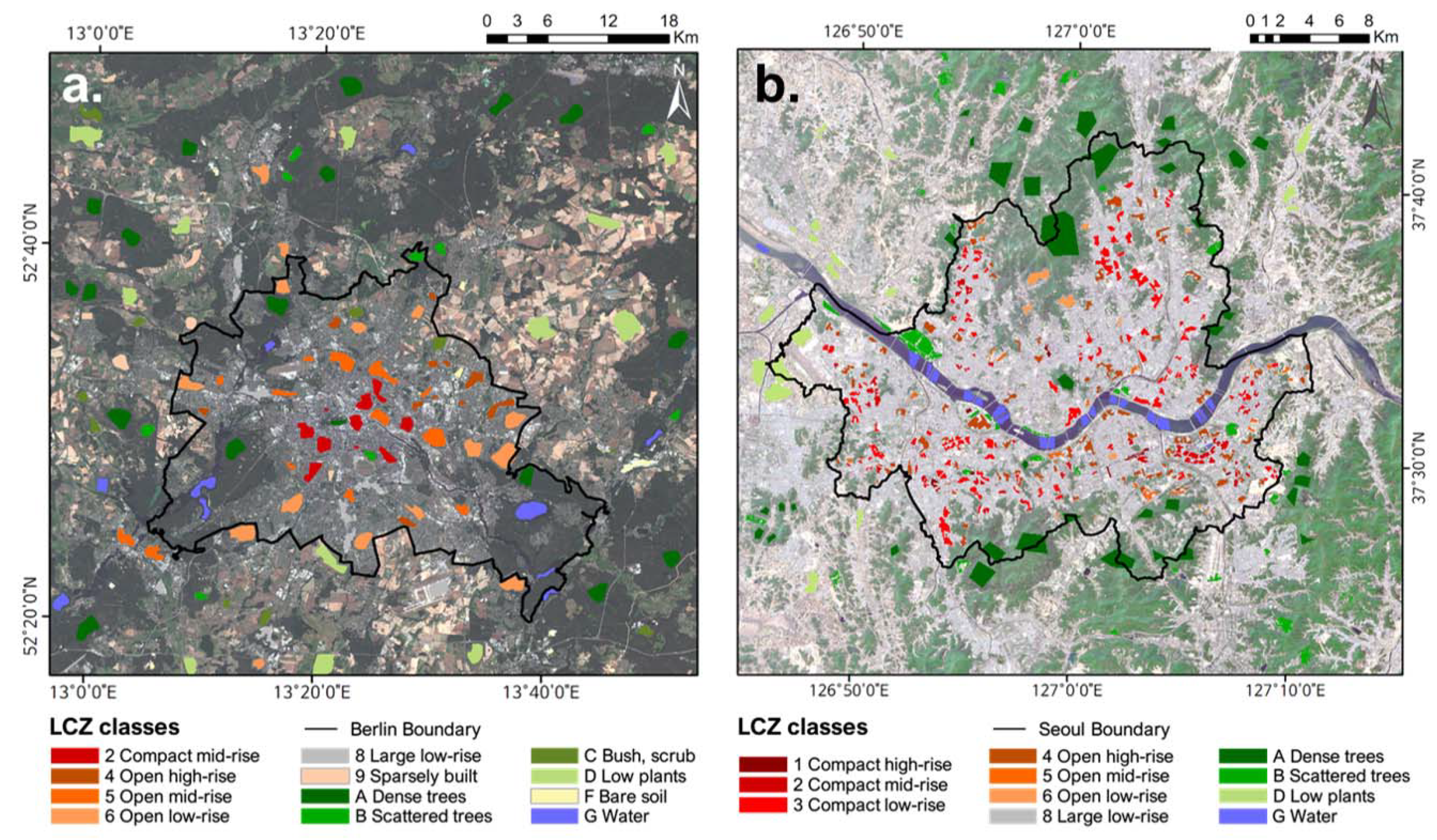

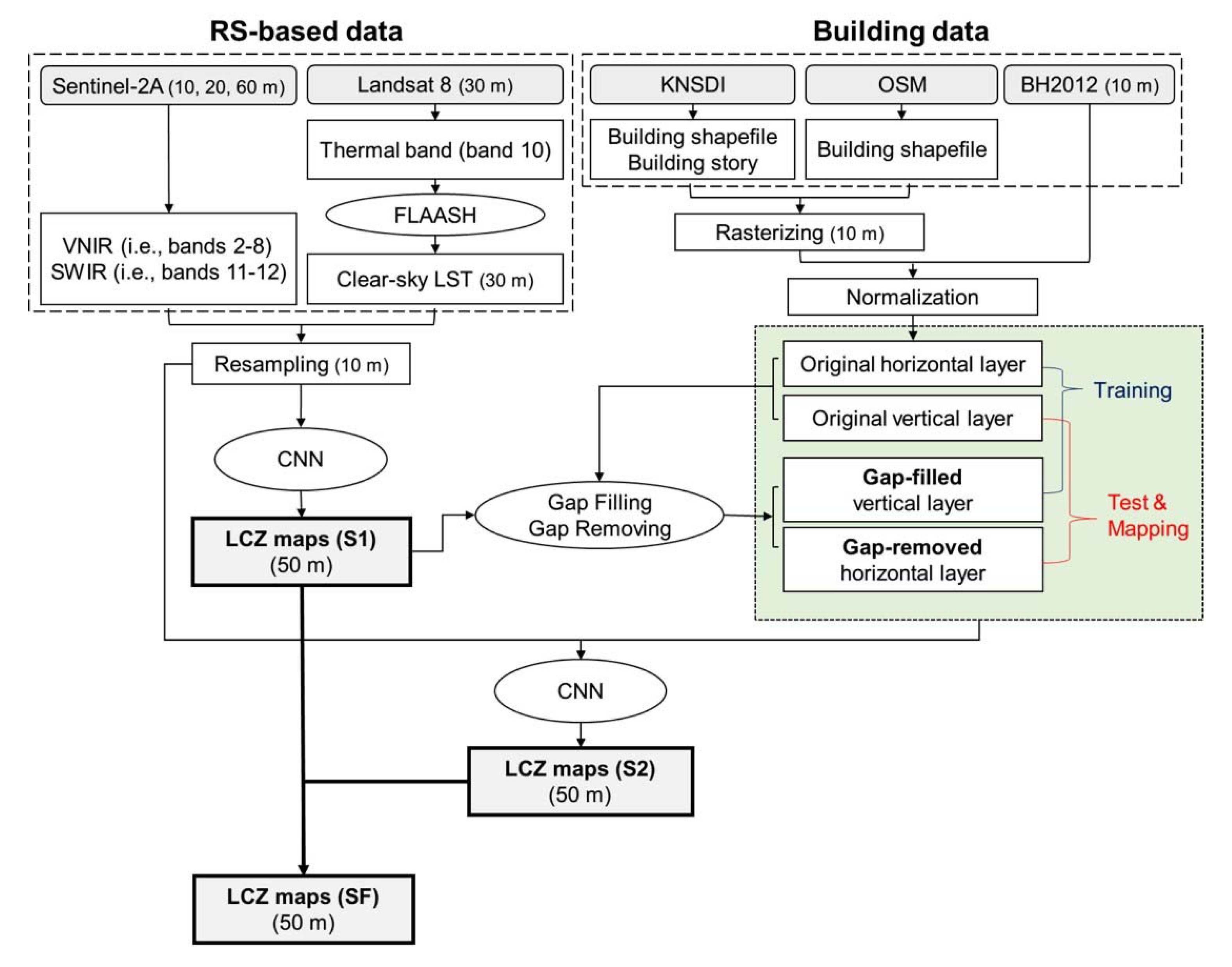
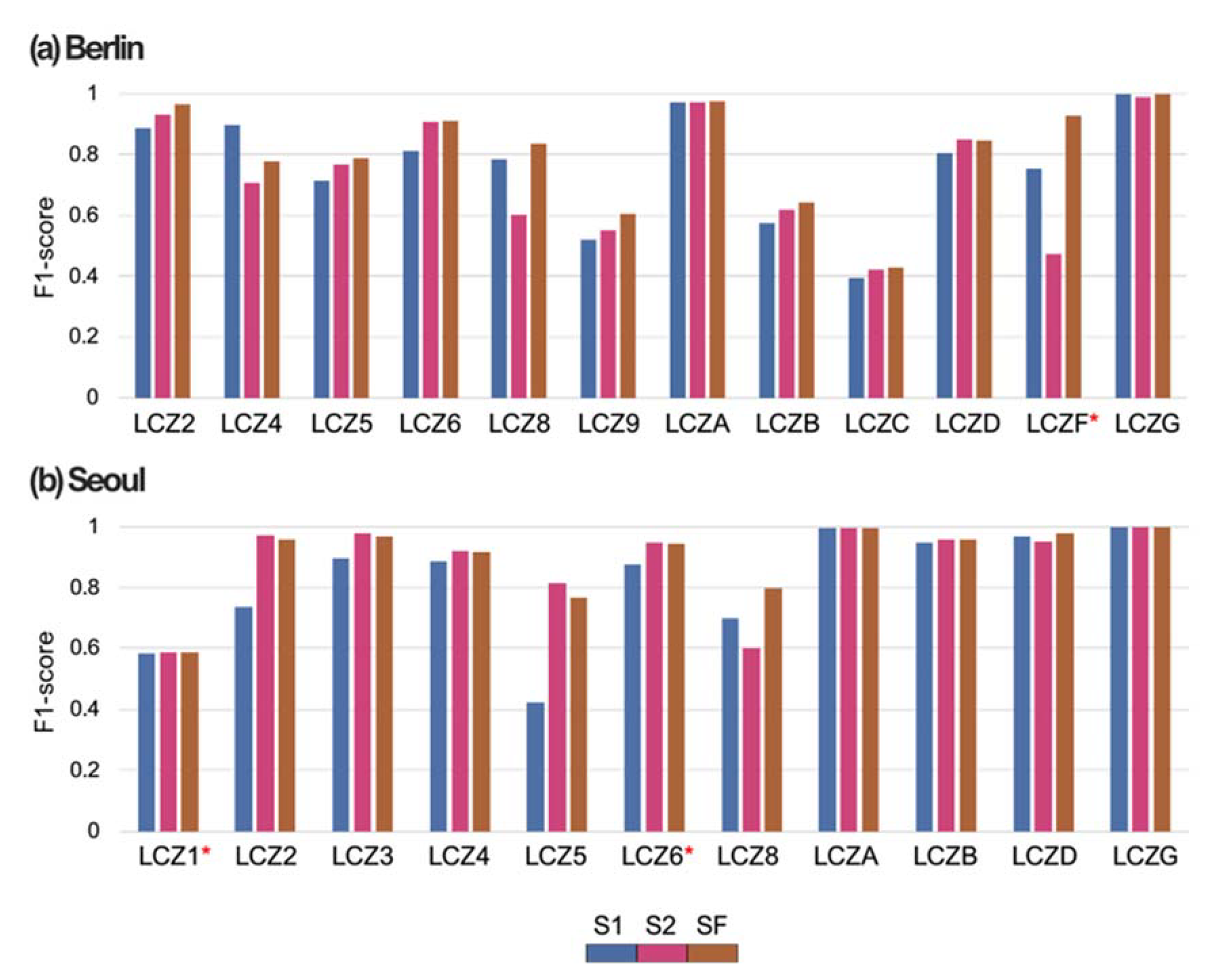
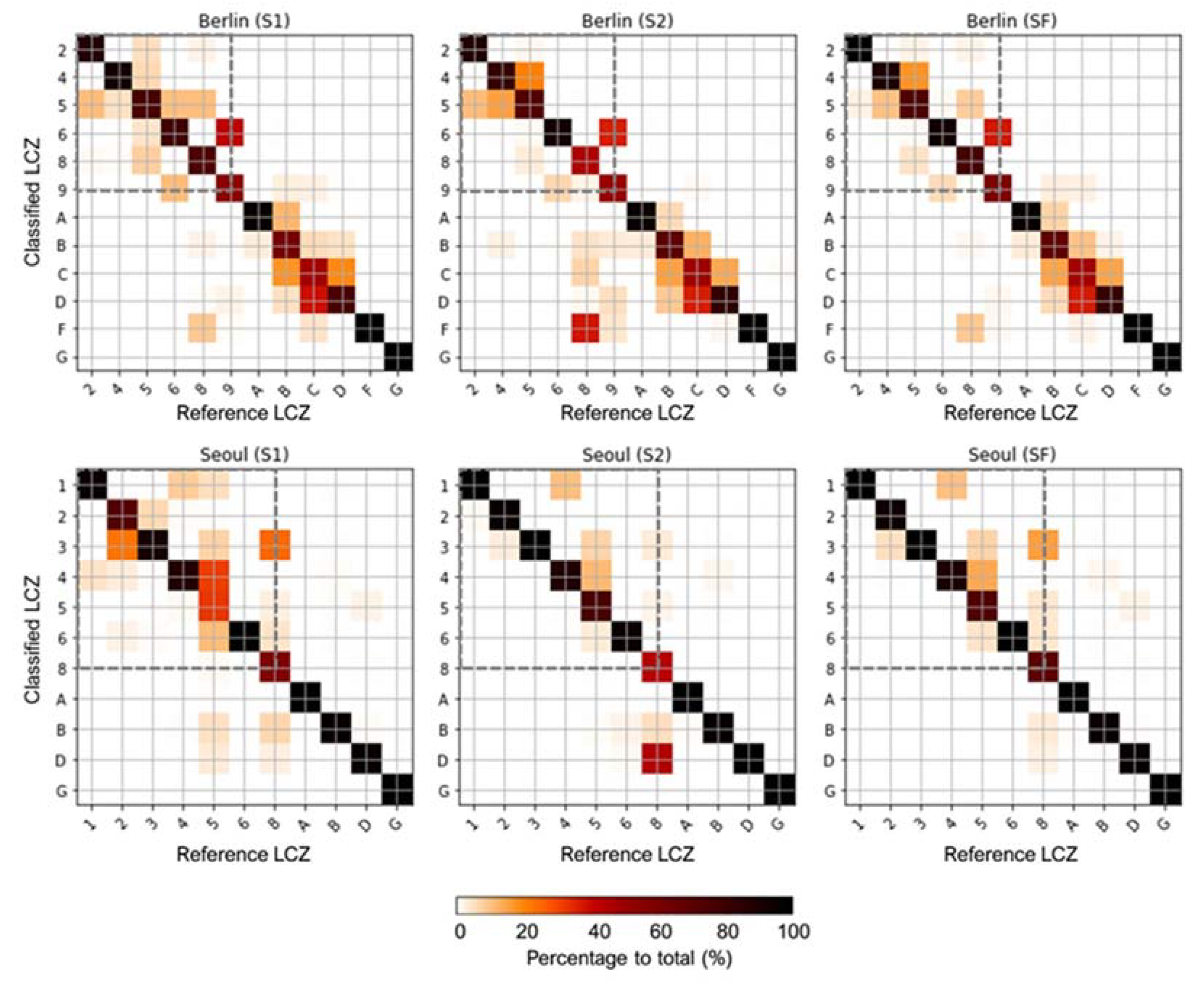
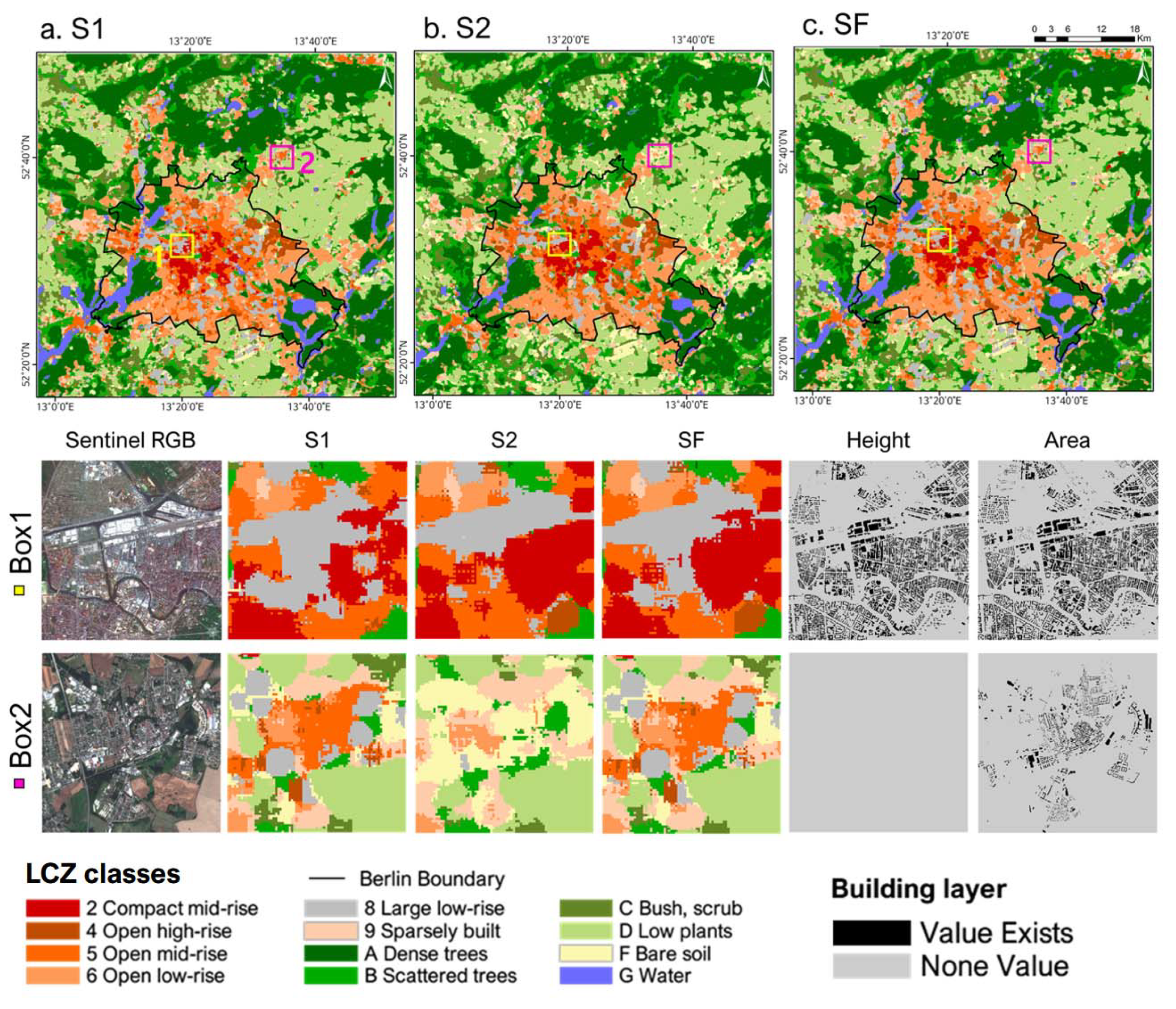
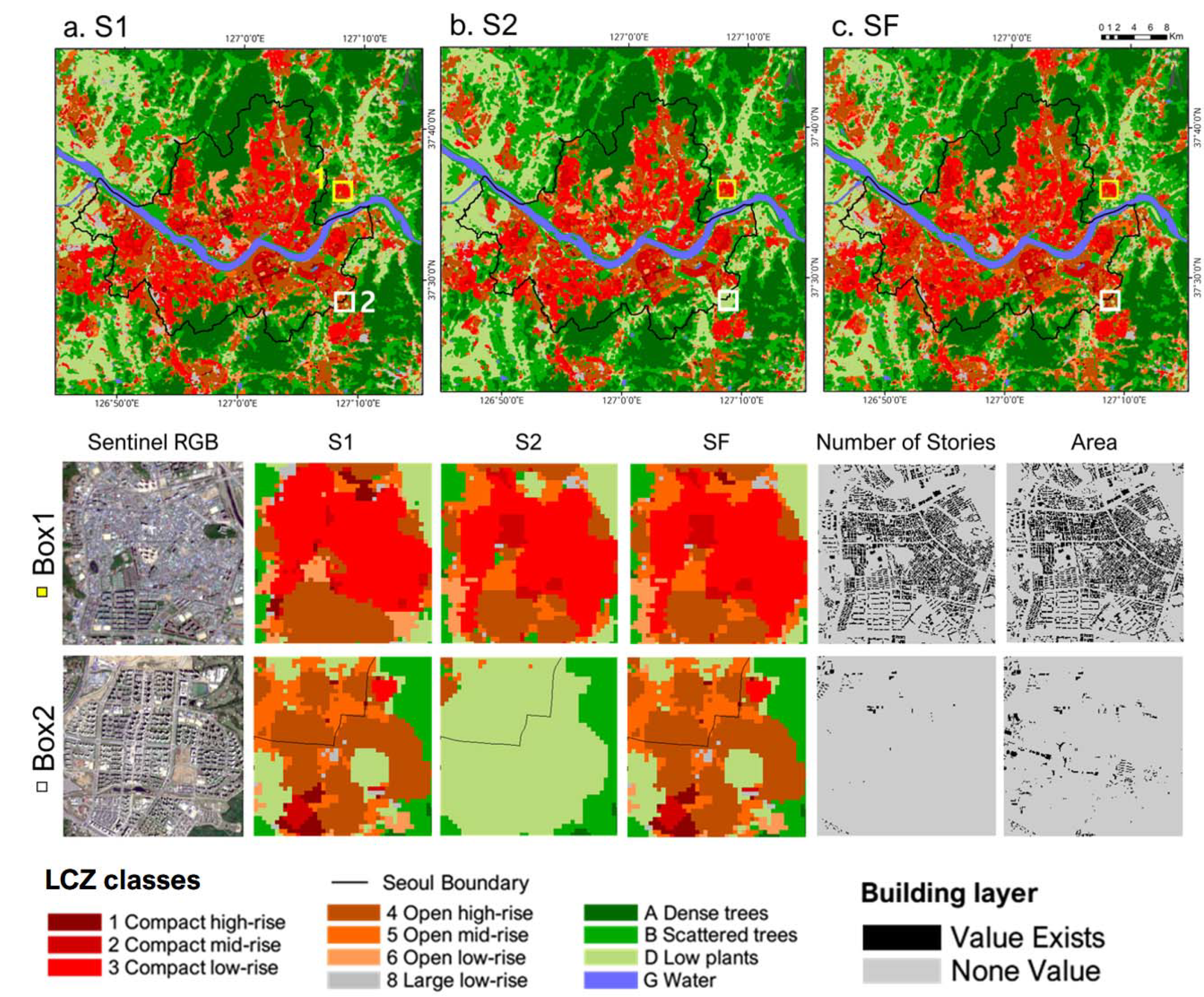
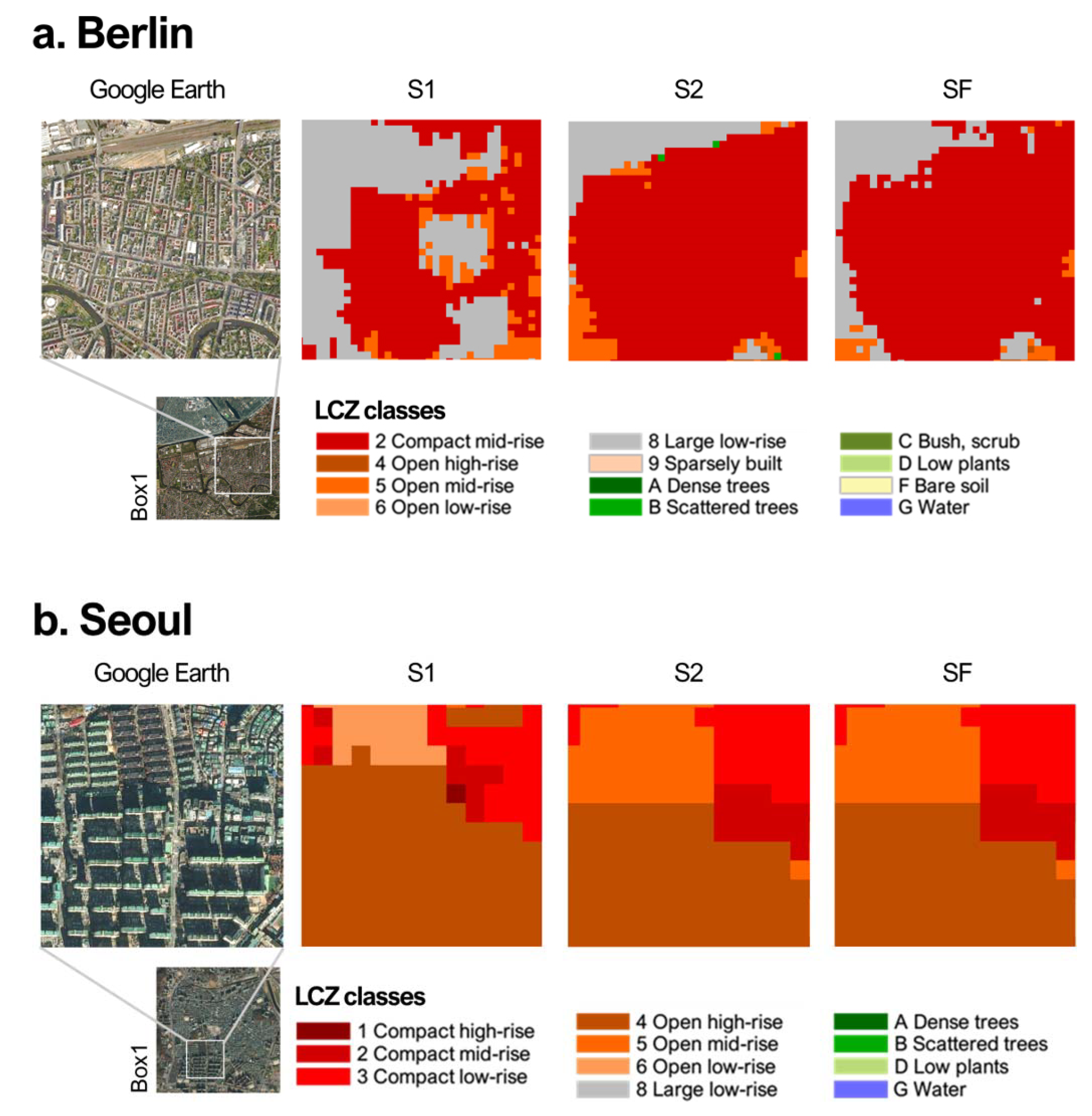
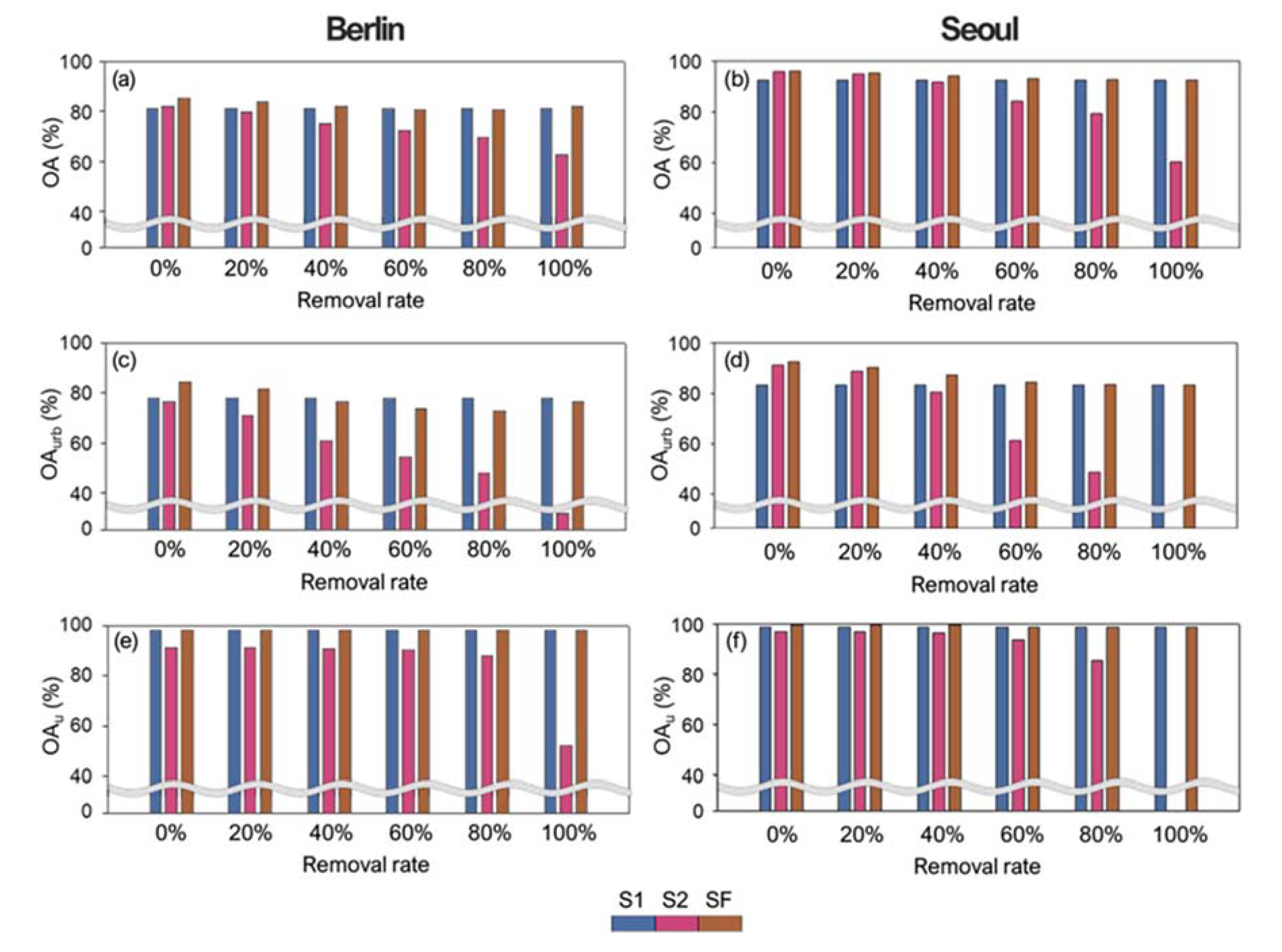
| LCZ | Berlin | Seoul | |||
|---|---|---|---|---|---|
| Training | Test | Training | Test | ||
 | LCZ1 Compact high-rise | - | - | 11(308) * | |
 | LCZ2 Compact midrise | 5(2748) | 5(2633) | 27(1073) | 27(690) |
 | LCZ3 Compact low-rise | - | - | 58(3271) | 57(2893) |
 | LCZ4 Open high-rise | 6(1847) | 5(1528) | 58(3024) | 37(2106) |
 | LCZ5 Open midrise | 8(4074) | 5(3430) | 10(403) | 10(394) |
 | LCZ6 Open low-rise | 8(6970) | 7(5319) | 13(917) * | |
 | LCZ7 Lightweight low-rise | - | - | - | - |
 | LCZ8 Large low-rise | 7(2663) | 7(2284) | 5(493) | 5(406) |
 | LCZ9 Sparsely built | 7(1592) | 5(1369) | - | - |
 | LCZ10 Heavy industry | - | - | - | - |
 | LCZA Dense trees | 9(8466) | 9(8520) | 19(7034) | 19(6375) |
 | LCZB Scattered trees | 5(1743) | 4(1509) | 24(2462) | 23(1893) |
 | LCZC Bush, scrub | 6(2108) | 4(1757) | - | - |
 | LCZD Low plants | 6(8325) | 6(6944) | 10(2698) | 10(1935) |
 | LCZE Bare rock or paved | - | - | - | - |
 | LCZF Bare soil or sand | 6(944) * | - | - | |
 | LCZG Water | 5(3152) | 5(2389) | 10(1247) | 9(1296) |
| Berlin | Seoul | |
|---|---|---|
| In whole area | 34.6% | 18.0% |
| In urban-type LCZ reference | ||
| LCZ1 | - | 4.9% |
| LCZ2 | 1.6% | 1.5% |
| LCZ3 | - | 3.6% |
| LCZ4 | 2.4% | 5.6% |
| LCZ5 | 8.0% | 4.2% |
| LCZ6 | 35.3% | 8.2% |
| LCZ7 | - | - |
| LCZ8 | 41.0% | 54.0% |
| LCZ9 | 100% | - |
| LCZ10 | - | - |
| RS-Based Data | S1 | S2 | |
| Nine Sentinel reflectance data (bands 2–8 and 11–12) and one Landsat-based LST | |||
| Building Data | S2 | ||
| Training | Testing and Mapping | ||
| Vertical component | Gap-filled vertical layer | Original vertical layer | |
| Horizontal component | Original area layer | Gap-removed horizontal layer | |
| Scheme | Berlin | Seoul | ||||
|---|---|---|---|---|---|---|
| OA % | OAurb% | OAu% | OA% | OAurb% | OAu% | |
| S1 | 81.1 | 77.7 | 97.9 | 92.5 | 83.4 | 98.7 |
| S2 | 82.1 | 76.6 | 91.2 | 95.9 | 91.2 | 96.9 |
| SF | 85.3 | 84.3 | 98.2 | 96.1 | 92.6 | 99.6 |
| Berlin | Seoul | |||||
|---|---|---|---|---|---|---|
| S1 | S2 | SF | S1 | S2 | SF | |
| LCZ1 | - | - | - | 1.1 | 0.3 | 0.4 |
| LCZ2 | 1.4 | 1.3 | 1.4 | 3.4 | 2.8 | 2.9 |
| LCZ3 | - | - | - | 9.0 | 9.6 | 10.2 |
| LCZ4 | 1.3 | 2.0 | 2.0 | 11.5 | 9.3 | 11.2 |
| LCZ5 | 5.8 | 3.4 | 4.5 | 4.3 | 3.7 | 6.3 |
| LCZ6 | 10.2 | 10.5 | 11.4 | 5.1 | 2.7 | 5.5 |
| LCZ7 | - | - | - | - | - | - |
| LCZ8 | 4.9 | 2.4 | 4.7 | 2.9 | 1.0 | 2.8 |
| LCZ9 | 5.6 | 4.8 | 5.9 | - | - | - |
| LCZ10 | - | - | - | - | - | - |
| LCZA | 25.7 | 25.5 | 25.1 | 24.4 | 23.2 | 23.1 |
| LCZB | 11.8 | 17.1 | 12.8 | 22.3 | 28.1 | 23.9 |
| LCZC | 6.8 | 6.3 | 5.8 | - | - | - |
| LCZD | 20.7 | 20.7 | 20.7 | 13.2 | 16.4 | 10.8 |
| LCZE | - | - | - | - | - | - |
| LCZF | 2.1 | 4.5 | 2.2 | - | - | - |
| LCZG | 3.7 | 1.5 | 3.4 | 2.8 | 2.9 | 2.9 |
Publisher’s Note: MDPI stays neutral with regard to jurisdictional claims in published maps and institutional affiliations. |
© 2020 by the authors. Licensee MDPI, Basel, Switzerland. This article is an open access article distributed under the terms and conditions of the Creative Commons Attribution (CC BY) license (http://creativecommons.org/licenses/by/4.0/).
Share and Cite
Yoo, C.; Lee, Y.; Cho, D.; Im, J.; Han, D. Improving Local Climate Zone Classification Using Incomplete Building Data and Sentinel 2 Images Based on Convolutional Neural Networks. Remote Sens. 2020, 12, 3552. https://doi.org/10.3390/rs12213552
Yoo C, Lee Y, Cho D, Im J, Han D. Improving Local Climate Zone Classification Using Incomplete Building Data and Sentinel 2 Images Based on Convolutional Neural Networks. Remote Sensing. 2020; 12(21):3552. https://doi.org/10.3390/rs12213552
Chicago/Turabian StyleYoo, Cheolhee, Yeonsu Lee, Dongjin Cho, Jungho Im, and Daehyeon Han. 2020. "Improving Local Climate Zone Classification Using Incomplete Building Data and Sentinel 2 Images Based on Convolutional Neural Networks" Remote Sensing 12, no. 21: 3552. https://doi.org/10.3390/rs12213552
APA StyleYoo, C., Lee, Y., Cho, D., Im, J., & Han, D. (2020). Improving Local Climate Zone Classification Using Incomplete Building Data and Sentinel 2 Images Based on Convolutional Neural Networks. Remote Sensing, 12(21), 3552. https://doi.org/10.3390/rs12213552




